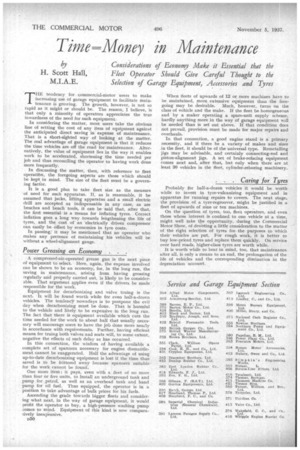Time Money in Maintenance
Page 74

If you've noticed an error in this article please click here to report it so we can fix it.
bY Considerations of Economy Make it Essential that the
H. Scott Hall, Fleet Operator Should Give Careful Thought to the M.I.A.E. Selection of Garage Equipment, Accessories and 7)r-es THE tendency for , cornmercial-motor users to make increasing use of garage equipment to facilitate maintenance is growing. The growth, however, is not so rapid as it might or should be. The reason, I believe, is that only a minority of operators appreciates the true inwardness of the need for such equipment.
In considering the matter, most users take the obvious line of setting the cost of any item of equipment against the anticipated direct saving in expense of maintenance. That is a short-sighted way of looking at the matter, The real advantage of garage equipment is that it reduces the time vehicles are off the road for maintenance. Alternatively, the value of equipment lies in the way it enables work to be accelerated, shortening the time needed per job and thus reconciling the operator to having work done more frequently.
In discussing the matter, then, with reference to fleet operatibn, the foregoing aspects are those which should be kept in mind. The size of the fleet must be a governing factor.
It is a good plan to take fleet size as the measure . of need for such apparatus. If, as is reasonable, it be assumed that jacks, lifting apparatus and a small electric drill are accepted as indispensable in any case, as are benches and bench tools, it can be said that, after that, the first essential is a means for inflating tyres. Correct inflation goes a long way towards lengthening the life of 'tyres, and the cost of an "electrically driven compressor can easily be offset by economies in tyre costs.
In passing,' it may be mentioned that no operator who makes any pretence of maintaining his vehicles will be without a wheel-alignment gauge.
Power Greasing an Economy . .
A compressed-air-operated grease gun is the next piece of equipment to select. Here, again, the expense involved can be shown to be an economy, for, in the long run, the saving in maintenance, arising from having greasing regularly and properly carried out, is likely to be considerable. That argument applies even if the drivers be made responsible for the work.
Equipment for decarbonizing and valve truing is the next. It will be found worth while for even half-a-dozen vehicles. The tendency nowadays is to postpone the evil day when decarbonizing must be done. That is harmful to the vehicle and likely to be expensive in the long run. The fact that there is equipment available which cuts the time needed for the' work to about half that usually necessary will encourage users to have the job done more nearly in accordance with requirements. Further, having efficient means for truing both valves and seats will, to some extent, negative the effects of such delay as has occurred.
In this connection, the wisdom of having available a complete set of spanners necessary for engine dismantlement cannot be exaggerated. Half the advantage of using up-to-date decarbonizing equipment is lost if the time thus saved is to be frittered away because spanners suitable for the work cannot be found.
One more item : it pays, even with a fleet of no more than four or five units, to install an underground tank and pump for petrol, as well as an overhead tank and hand pump for oil fuel. Thus equipped, the operator is in a position to take advantage of bulk prices for his fuels.
Ascending the grade towards bigger fleets and considering what next, in the way of garage equipment, it would profit the operator to buy, a high-pressure washing pump comes to mind. Equipment of this kind is now comparatively inexpensive.
n50 When fleets of upwards of 12 or more machines have to be maintained, more, extensive equipment than the foregoing may be desirable. Much, however, turns on the class of vehicle and the make. If the fleet be homogeneous and by a maker operating a spare-unit supply scheme, hardly anything more in the way of garage equipment will be needed than is set out above. If that condition does not prevail, provision must be made for major repairs and overhauls.
In that connection, a good engine stand is a primary necessity, and if there be a variety of makes and sizes in the fleet, it should be of the universal type. Remetalling jigs may be advisable, and certainly connecting-rod and piston-alignment jigs. A set of brake-refacing equipment comes next and, after that, but only when there are at least 30 vehicles in the fleet, cylinder-reboring machinery.
. Caring for Tyres
Probably for half-a-dozen vehicles it would be worth while to invest in tyre-vulcanizing equipment and in apparatus for running repairs to covers. The next stage, the provision of a tyre-regroover, might be justified in a fleet of upwards of nine or ten machines.
On the question of tyres, too, fleet operators, and even those whose interest is confined to one vehicle at a time, might well take the opportunity, during the Commercial Motor Show, of devoting a little consideration to the matter of the right selection of tyres forthe purposes to which their vehicles are put. For rough work, it is better to buy low-priced tyres and replace them quickly. On service over hard roads, higher-class tyres are worth while.
It is worth while to bear in mind, too, that maintenance after all, iS only a means to an end, the prolongation of the life of vehicles and the corresponding diminution in the depreciation account.


















































































